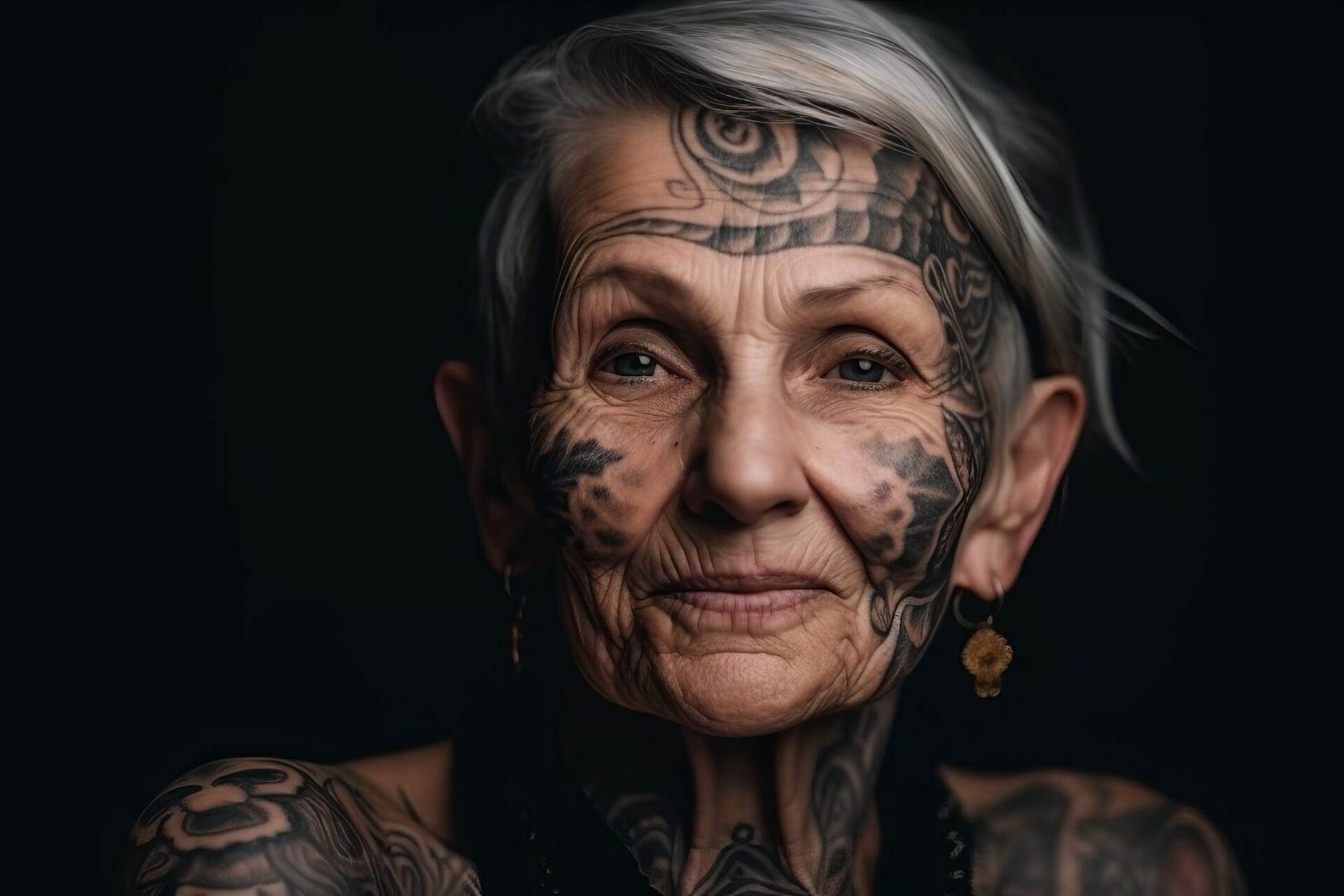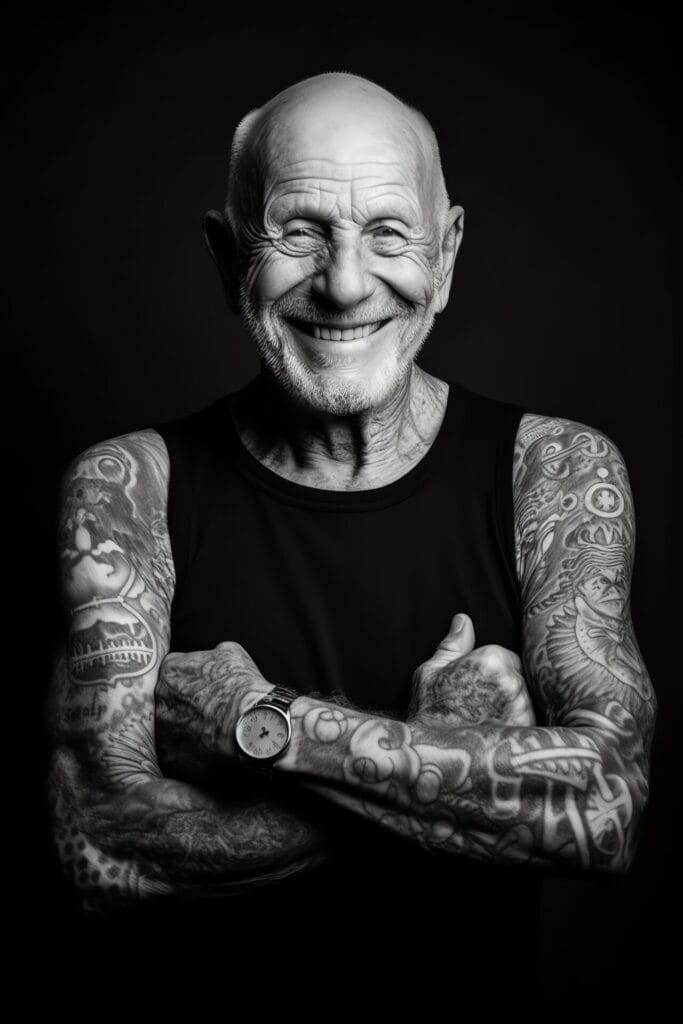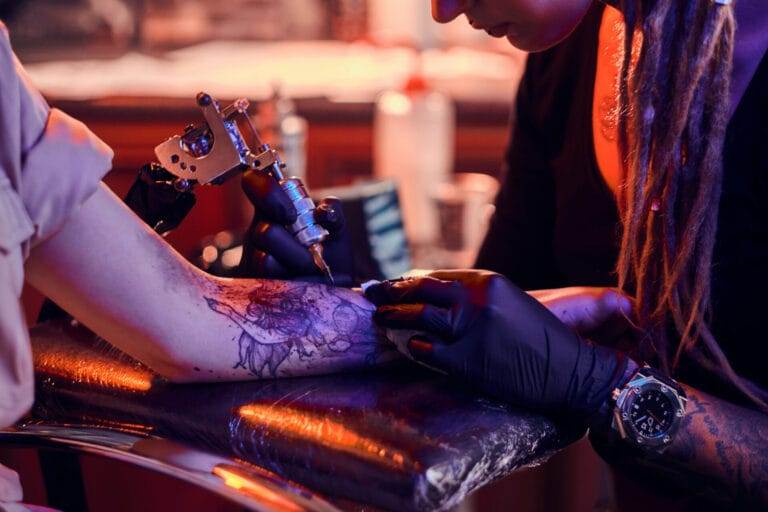
Tattoos are not merely static images etched onto the skin; they are living, breathing works of art that evolve alongside the body. As the skin ages, tattoos undergo natural transformations, reflecting the passage of time and the wearer’s personal journey. This dynamic nature of tattoos is a testament to the intricate relationship between the human body and the art that adorns it.
The evolution of tattoos is a captivating process, one that showcases the resilience and adaptability of the human canvas. As the skin loses its youthful elasticity and undergoes various changes, the tattoos that once adorned it transform, taking on new forms and textures. This transformation is not merely a physical phenomenon; it is a visual representation of the wearer’s life experiences, a tapestry of memories and emotions woven into the very fabric of their being.
The evolving nature of tattoos is a testament to the enduring power of body art. Rather than viewing them as static entities, we must embrace the idea that tattoos are living, breathing extensions of the self, constantly adapting and changing to reflect the wearer’s personal growth and the passage of time. This understanding not only deepens our appreciation for the art form but also encourages us to celebrate the unique stories that each aging tattoo has to tell.
Key Takeaways
- Tattoos change over time as the skin ages, stretches, and loses elasticity.
- Sun exposure can cause tattoos to fade and lose their vibrancy over time.
- Proper tattoo maintenance, including moisturizing and using sunscreen, can help preserve the appearance of ink.
- Embracing the aged aesthetic of weathered tattoos can be a beautiful way to celebrate the stories behind the ink.
- Generational differences in tattoo trends and perceptions can influence how aging ink is viewed and appreciated.
Fading Ink: The Natural Progression of Tattoo Pigments
Tattoo pigments, much like the skin they are embedded in, are susceptible to the natural processes of aging and fading. This gradual transformation is a testament to the dynamic nature of body art, as the vibrant hues and sharp lines that once defined a tattoo gradually soften and blur over time.
The rate at which tattoo pigments fade is influenced by a variety of factors, including the wearer’s skin tone, the artist’s technique, and the exposure to sunlight. Individuals with lighter skin tones may experience more pronounced fading, as the contrast between the tattoo and the surrounding skin becomes less pronounced. Similarly, tattoos that are exposed to significant amounts of ultraviolet radiation from the sun can fade more quickly, as the pigments are broken down by the sun’s powerful rays.
The artist’s technique also plays a crucial role in the longevity of a tattoo. Skilled tattoo artists understand the importance of proper ink placement and the use of high-quality pigments, both of which can contribute to the tattoo’s ability to withstand the test of time. Poorly executed tattoos, on the other hand, may fade more rapidly, as the ink is not evenly distributed or the pigments used are of inferior quality.
The natural progression of tattoo pigments is a testament to the dynamic nature of body art. Rather than viewing fading as a negative, we must embrace it as a natural and inevitable part of the tattoo’s life cycle. This transformation adds depth and character to the design, creating a unique and personalized work of art that reflects the wearer’s journey through life.
Skin Elasticity and Tattoo Transformation
The skin’s elasticity plays a crucial role in how tattoos age and change over time. As the skin loses its youthful suppleness, the tattoos that adorn it undergo a remarkable transformation, adding depth and character to the design.
As the skin ages, it becomes less elastic and more prone to sagging and wrinkling. This natural process can have a significant impact on the appearance of tattoos, causing them to stretch, distort, or even appear to “move” on the body. While this may seem like a negative consequence, it is, in fact, a testament to the dynamic nature of body art.
The transformation of tattoos due to skin elasticity is a unique and captivating phenomenon. A tattoo that once appeared crisp and defined may gradually take on a more organic, fluid appearance as the skin around it changes. This can add a sense of depth and character to the design, creating a visual representation of the wearer’s personal journey.
Moreover, the way a tattoo transforms can also be a reflection of the wearer’s own physical and emotional changes. As the body ages and experiences various life events, the tattoos that adorn it can serve as a visual chronicle of these experiences, evolving alongside the wearer and becoming a part of their unique story.
Embracing the transformation of tattoos due to skin elasticity is an act of self-acceptance and celebration of the human experience. Rather than viewing these changes as a negative, we must recognize them as a testament to the resilience and adaptability of the human body and the art that adorns it.
Sun Exposure and Its Impact on Tattoo Longevity
Ultraviolet radiation from the sun can have a significant impact on the longevity and vibrancy of tattoos. The sun’s powerful rays can break down the pigments used in tattoos, causing them to fade and lose their original vibrancy over time.
The degree to which sun exposure affects a tattoo’s appearance is influenced by a variety of factors, including the wearer’s skin tone, the location of the tattoo on the body, and the artist’s technique. Individuals with lighter skin tones may experience more pronounced fading, as the contrast between the tattoo and the surrounding skin becomes less pronounced. Similarly, tattoos that are located on areas of the body that are frequently exposed to the sun, such as the arms or legs, are more susceptible to fading than those in more protected areas.
The artist’s technique also plays a crucial role in the longevity of a tattoo. Skilled tattoo artists understand the importance of proper ink placement and the use of high-quality pigments, both of which can contribute to the tattoo’s ability to withstand the test of time. Poorly executed tattoos, on the other hand, may fade more rapidly, as the ink is not evenly distributed or the pigments used are of inferior quality.
Proper sun protection and aftercare are essential to maintaining the vibrancy and clarity of tattoos, even as they age. This may include the use of sunscreen, protective clothing, and regular touch-ups with a skilled tattoo artist. By taking these precautions, wearers can help to ensure that their tattoos remain a vibrant and enduring part of their personal expression.
The impact of sun exposure on tattoo longevity is a testament to the dynamic nature of body art. Rather than viewing fading as a negative, we must recognize it as a natural and inevitable part of the tattoo’s life cycle, one that adds depth and character to the design and reflects the wearer’s personal journey.
Tattoo Maintenance: Keeping Your Ink Looking Fresh
| Metrics | Before Aging | After Aging |
|---|---|---|
| Color Fading | Minimal | Significant |
| Line Blurring | No | Yes |
| Size Change | No | Minimal |
| Overall Appearance | Sharp | Softened |
Maintaining the appearance of aging tattoos is an essential aspect of body art. As tattoos evolve over time, regular moisturizing and touch-ups can help to mitigate the effects of aging and keep the ink looking fresh and vibrant.
Proper moisturizing is crucial for maintaining the appearance of tattoos, as the skin’s natural oils and moisture can help to prevent fading and distortion. Wearers should make a habit of applying high-quality moisturizers to their tattoos, especially in areas that are exposed to the sun or subject to frequent movement.
In addition to moisturizing, regular touch-ups with a skilled tattoo artist can help to refresh and revitalize aging tattoos. Over time, the lines and colors of a tattoo may become blurred or faded, and a skilled artist can use their expertise to reinvigorate the design. This may involve adding new ink, sharpening the lines, or even incorporating new elements into the existing tattoo.
Consulting with experienced tattoo artists for maintenance and touch-ups is essential for ensuring that your ink remains vibrant and true to the original design. These professionals understand the unique challenges of working with aging tattoos and can provide personalized recommendations and solutions to keep your body art looking its best.
By embracing the process of tattoo maintenance, wearers can celebrate the evolution of their body art and ensure that it remains a vibrant and enduring part of their personal expression. This commitment to self-care and artistic preservation not only preserves the beauty of the tattoo but also honors the wearer’s journey and the story that their body art represents.

Embracing the Aged Aesthetic: The Beauty of Weathered Tattoos
Aged tattoos can take on a unique and visually striking appearance, reflecting the wearer’s life experiences and adding depth and character to their body art. Rather than viewing the natural evolution of tattoos as a negative, we must embrace the aged aesthetic and celebrate the beauty that comes with the passage of time.
As tattoos age, they can develop a weathered, textured appearance that adds a sense of depth and authenticity to the design. The softening of lines, the blending of colors, and the subtle distortions caused by the skin’s elasticity can all contribute to this aged aesthetic, creating a visual representation of the wearer’s personal journey.
This aged aesthetic is not a sign of neglect or poor care; rather, it is a testament to the resilience and adaptability of the human body and the art that adorns it. Embracing the natural evolution of tattoos can be a powerful act of self-acceptance and celebration of one’s personal growth and transformation.
Moreover, the aged aesthetic of tattoos can serve as a visual chronicle of the wearer’s life experiences, a tapestry of memories and emotions woven into the very fabric of their being. Each line, each faded color, and each subtle distortion can tell a story, inviting the viewer to engage with the tattoo on a deeper, more meaningful level.
By embracing the aged aesthetic of tattoos, we not only celebrate the art form itself but also the human experience that it represents. This understanding fosters a deeper appreciation for the resilience and adaptability of the human body and the enduring power of self-expression through body art.
Tattoo Removal and Revitalization: Options for Refreshing Your Ink
For those seeking to update or remove aging tattoos, modern techniques such as laser removal and cover-ups offer viable solutions. These options provide a fresh canvas for new artistic expressions or the opportunity to reclaim one’s body.
Laser removal has become an increasingly popular method for removing or fading unwanted tattoos. This process uses targeted pulses of light to break down the tattoo pigments, allowing the body to naturally absorb and eliminate them over time. While laser removal can be an effective solution, it is important to work with experienced professionals who can ensure the safe and effective removal of the tattoo.
In addition to laser removal, cover-ups offer another option for refreshing aging tattoos. This technique involves the application of a new, larger tattoo design that effectively “covers up” the original ink. Cover-ups can be an excellent choice for those who wish to retain a connection to their past while creating a new, updated expression on their body.
Exploring these options can provide wearers with the opportunity to reclaim their body and create a fresh canvas for new artistic expressions. Whether it’s removing an outdated or unwanted tattoo or covering it up with a new design, these techniques offer a chance for personal growth and transformation.
By embracing the possibilities of tattoo removal and revitalization, wearers can celebrate the evolution of their personal style and the changing nature of their self-expression. This process can be a powerful act of self-empowerment, allowing individuals to take control of their body art and create a new, meaningful representation of their identity.
Generational Differences in Tattoo Trends and Perceptions
Attitudes towards tattoos have evolved over time, with younger generations often more accepting and embracing of body art. Understanding these generational shifts can provide insight into the changing perceptions and cultural significance of aging tattoos.
In recent decades, tattoos have become increasingly mainstream, with a growing acceptance and even celebration of body art across various age groups and social demographics. This shift is particularly evident among younger generations, who have grown up in a more tattoo-friendly cultural landscape.
Younger individuals, often millennials and Gen Z, tend to view tattoos as a form of self-expression and personal identity. They may be more inclined to see aging tattoos as a testament to their life experiences and personal growth, rather than as a sign of poor judgment or a lack of foresight.
In contrast, older generations may have grown up in a time when tattoos were more heavily stigmatized and associated with marginalized or rebellious subcultures. As a result, they may be more likely to view aging tattoos as a sign of regret or a youthful indiscretion.
These generational differences in tattoo perceptions can have a significant impact on how individuals approach and embrace the natural evolution of their body art. Younger wearers may be more inclined to celebrate the aged aesthetic of their tattoos, while older individuals may feel the need to cover up or remove their aging ink.
Understanding these generational shifts can provide valuable insights into the changing cultural significance of tattoos and the way they are perceived over time. By recognizing and respecting these differences, we can foster a more inclusive and understanding environment for individuals of all ages to express themselves through body art.
The Art of Acceptance: Celebrating the Story Behind Aging Tattoos
Aging tattoos are a testament to the wearer’s life experiences, serving as a visual chronicle of their personal growth and transformation. Embracing and celebrating the story behind these aging tattoos can foster a deeper appreciation for the art of body modification and the human experience it represents.
Each tattoo is a unique expression of the wearer’s identity, a reflection of their passions, beliefs, and memories. As these tattoos age, they take on a new layer of meaning, becoming a visual representation of the wearer’s journey through life. The faded lines, the blended colors, and the subtle distortions all contribute to the tattoo’s ability to tell a story, inviting the viewer to engage with the art on a deeper, more meaningful level.
By celebrating the story behind aging tattoos, we not only honor the art form itself but also the resilience and adaptability of the human body. These tattoos are a testament to the wearer’s ability to embrace change, to grow and evolve, and to carry their experiences with them as a visible part of their identity.
Moreover, the celebration of aging tattoos can foster a sense of community and shared understanding. As individuals come together to share their stories and appreciate the unique beauty of weathered body art, they create a space for mutual understanding and acceptance. This can be particularly empowering for those who have faced stigma or judgment for their tattoos, as it allows them to reclaim their body art and the personal narrative it represents.
Embracing the art of acceptance when it comes to aging tattoos is not just about appreciating the visual aesthetics; it is about honoring the human experience that these tattoos represent. By celebrating the story behind each weathered tattoo, we can deepen our understanding of the human condition and the enduring power of self-expression through body art.
FAQs
What is the process of aging ink in tattoos?
The process of aging ink in tattoos involves the gradual fading and blurring of the tattoo design over time. This can be caused by various factors such as exposure to sunlight, the natural aging of the skin, and the quality of the ink used.
Why do tattoos fade over time?
Tattoos fade over time due to the natural regeneration of skin cells, exposure to UV rays from the sun, and the breakdown of the ink particles within the skin. Additionally, the quality of the ink and the skill of the tattoo artist can also impact the longevity of a tattoo.
How can one slow down the aging of ink in tattoos?
To slow down the aging of ink in tattoos, it is important to protect the tattoo from direct sunlight by using sunscreen and wearing protective clothing. Keeping the skin moisturized and avoiding excessive exfoliation can also help maintain the vibrancy of the tattoo.
Can aging ink in tattoos be reversed?
While it is not possible to completely reverse the aging of ink in tattoos, certain treatments such as touch-ups, laser tattoo removal, and tattoo cover-ups can help refresh and enhance the appearance of an aging tattoo.
What are some common misconceptions about aging ink in tattoos?
One common misconception is that all tattoos will inevitably fade and blur over time. While some fading is natural, proper aftercare and maintenance can significantly prolong the vibrancy of a tattoo. Additionally, the skill of the tattoo artist and the quality of the ink can also impact the longevity of a tattoo.





